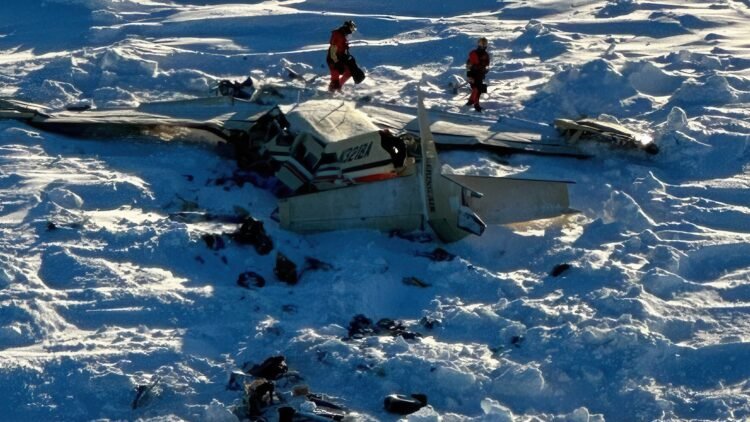JUNEAU, Alaska (AP) — Just hours after the devastating discovery of 10 people dead in western Alaska, authorities raced against time to recover their remains and the wreckage of a small commuter plane before worsening weather conditions complicated the already treacherous recovery effort. The crash is one of the deadliest aviation disasters in the state in 25 years.
Jim West, chief of the Nome Volunteer Fire Department, emphasized the urgency of the situation, stating, “The conditions out there are dynamic, so we’ve got to do it safely in the fastest way we can.”
The ill-fated Bering Air single-engine turboprop plane was en route from Unalakleet to Nome, a key transportation hub for the region, when it vanished from radar on Thursday afternoon. After an extensive and urgent search effort, the aircraft was discovered the next day on unstable sea ice, with all nine passengers and the pilot tragically confirmed dead.
As the tight-knit Alaskan community grapples with the immense loss, recovery crews have been working swiftly to remove the bodies and wreckage before the arrival of high winds and heavy snowfall. The challenging location of the crash site on slushy, shifting sea ice has added another layer of complexity to the operation. Officials have confirmed that once the bodies are removed, a Black Hawk helicopter will be used to lift and transport the wreckage.
Among the victims identified so far are Rhone Baumgartner and Kameron Hartvigson. The two men had traveled to Unalakleet to service a heat recovery system essential to the community’s water plant, according to the Alaska Native Tribal Health Consortium. “These two members of our team lost their lives serving others,” David Beveridge, vice president of environmental health & engineering for the organization, said in a heartfelt statement. “The loss of these two incredible individuals, along with everyone else on board the plane, will be felt all over Alaska.”
The identities of the remaining victims have not yet been released, but officials confirmed that all 10 individuals aboard the flight were adults. The aircraft was operating as part of a regularly scheduled commuter route, according to Lt. Ben Endres of the Alaska State Troopers.
A harrowing image provided by the U.S. Coast Guard reveals the splintered body of the plane lying shattered across the fragile ice, with debris scattered around the wreckage. Two emergency responders, clad in brightly colored safety gear, can be seen surveying the grim scene.
Alaska’s harsh and unpredictable weather, combined with its reliance on small aircraft for transportation across vast and remote regions, has historically contributed to a high incidence of aviation accidents. This tragic event underscores the challenges of flying in the state’s extreme conditions and the resilience of those who depend on air travel for essential services and connectivity.
As authorities continue their recovery efforts, the community remains in mourning, struggling to comprehend the profound loss. With an impending snowstorm approaching, every minute is crucial in ensuring that those lost are brought home to their loved ones, and that investigators can piece together what led to this catastrophic crash.








































